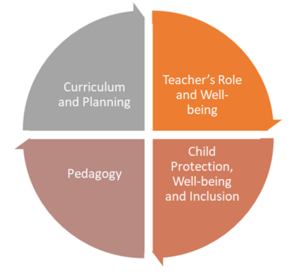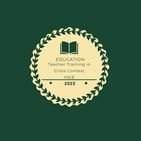CAS Digital Learning in Emergencies/module4-Enas&Manal: Difference between revisions
| (One intermediate revision by the same user not shown) | |||
| Line 55: | Line 55: | ||
|} | |} | ||
=== Project Open Educational Resouces === | |||
For the project, the following Open Education Resources OER were chosen: | For the project, the following Open Education Resources OER were chosen: | ||
{| class="wikitable" | {| class="wikitable" | ||
| Line 106: | Line 106: | ||
'''Target audience:''' This training is intended to support teachers’ progress towards development of the competencies. | '''Target audience:''' This training is intended to support teachers’ progress towards development of the competencies. | ||
=== Project's objective === | |||
'''Global objective:''' Better support for teachers working in crisis contexts will help ensure that children and youth receive the right to inclusive and equitable quality education, and that global commitments—such as the Sustainable Development Goals and the Global Compact on Refugees—are fulfilled. | '''Global objective:''' Better support for teachers working in crisis contexts will help ensure that children and youth receive the right to inclusive and equitable quality education, and that global commitments—such as the Sustainable Development Goals and the Global Compact on Refugees—are fulfilled. | ||
Latest revision as of 13:32, 4 August 2022
Introduction
This page is part of CAS Digital Learning in Emergencies (module 4) and is prepared by Manal Kheder & Enas Alsaid
Learning outcomes
- Open learning education and the potential advantages of adopting OER and Open Education approaches in different contexts.
- Recognize relevant concepts such as OER, Open Educational Practices, open content, open pedagogy, open assessment.
- Apply Open Licenses to the content.
- Recognize different types of open educational practices and initiatives.
Time necessary: 33 Hours
Detailed description
The project is composed of five steps:
- The project, i.e. describing the resources; setting objectives; specifying target audience; designing learning activities; choosing learning environment; specifying assessment.
- Finding relevant OER for the project, i.e. either re-using those identified during Activity 3 or new ones.
- Scripting activities with Open Educational Practices, specifying the roles of the different stakeholders.
- Reflecting and designing evaluation criteria to create an Open Badge.
- Publishing and sharing the project on an Open platform.
Activities
| Activity | Duration | Date | Product / output |
| Define the project, i.e. describe the resources; set objectives; specify target audience; design learning activities; choose learning environment; specify assessment | 3 h | 1-4 May 2022 | Project designed |
| Project OER | 6 h | 4-8 May 2022 | OER for the project chosen |
| Script 1 activity with OEP | 10 h | 8-12 May 2022 | Script activities prepared |
| Design evaluation criteria | 5 h | 12-15 May 2022 | Evaluation criteria identified |
| Create an Open badge | 5 h | 15-20 May 2022 | Open badge created |
| Publish and share the project on the chosen Open platform | 4 h | 20-25 May 2022 | Project published |
Project Open Educational Resouces
For the project, the following Open Education Resources OER were chosen:
| Title | URL | Type of openness/ Licensing |
| Teachers in Crisis Contexts Training for Primary School Teachers | https://inee.org/resources/teachers-crisis-contexts-training-primary-school-teachers | CC BY |
| DCA Remote TiCC Training Package | https://inee.org/resources/dca-remote-ticc-training-package | CC BY |
| DCA Digital Learning Materials | https://drive.google.com/drive/folders/1irZsI3L4KLRFwT_j12YeJMzAPqGgoFqy | CC BY |
| Case Studies & Teacher Stories Live Map | https://inee.org/ticc-event-series/map | CC BY |
| Mobile Mentoring for Primary School Teachers in Crisis Contexts | https://www.ungei.org/publication/mobile-mentoring-primary-school-teachers-crisis-contexts | CC BY |
| TEACHERS IN CRISIS CONTEXTS
Promising Practices in Teacher Management, Professional Development, and Well-being |
https://inee.org/resources/teachers-crisis-contexts-promising-practices-teacher-management-professional | CC BY SA |
| Teacher Wellbeing in Crisis Contexts - Good practice, lessons learned and opportunities for change | https://www.youtube.com/watch?v=I7rdymw5Qpw | Public Domain |
Project Description
The Teachers in Crisis Context (TiCC) Digital Training builds basic teaching competencies for unqualified or under-qualified teachers recruited to teach children in emergency settings (e.g. refugee/Internally Displaced Populations (IDP) camps, conflict-affected areas, post-natural disasters, and/or with highly vulnerable populations). The training is directly linked to Inter-agency Network for Education in Emergencies’ (INEE) standards and materials for the training are well-designed and provided in the INEE network. The training is comprised of four core modules, developed around a set of 28 teacher competencies. The modules are:
- Teacher’s Role and Well-being
- Child Protection, Well-being and Inclusion
- Pedagogy
- Curriculum and Planning
The whole training will be conducted digitally and materials in this training will be available online, open, and will benefit teachers who either find themselves teaching in crisis-affected environments or in host community schools that are integrating children/youth from displaced populations.
Target audience: This training is intended to support teachers’ progress towards development of the competencies.
Project's objective
Global objective: Better support for teachers working in crisis contexts will help ensure that children and youth receive the right to inclusive and equitable quality education, and that global commitments—such as the Sustainable Development Goals and the Global Compact on Refugees—are fulfilled.
Specific objective: By the end of the training, learners will acquire skills to practice strategies for a safe, inclusive and effective learning environment.
Learning outcomes:
- Learners will will be able to practice strategies to maintain well-being including mindfulness, conflict resolution and stress management techniques to overcome their challenges.
- Learners will able to promotes a classroom and school environment free from abuse, discrimination, exploitation, and violence, including sexual and gender-based violence.
- Learners will be able develop plans are in line with curriculum objectives, scope and sequence using child centered methodology.
Project design
The activities of the training is designed to allow participants’ engagement and participation, and to center them in the training. It is participatory, and relevant for participants’ professional and personal development. Pedagogical approach is associative (learning as activity) and will be building on prior learning (constructivism).
The training modules will be delivered remotely in synchronous and asynchronous sessions on EduTechWiki and Zoom. Participants will be requested to complete homework assignments in between modules and through homeworks, materials and tasks will be uploaded on EduTechWiki. The synchronous sessions include a diversity of instructional methods to ensure the training is interactive and the participants are engaged.
All materials and resources will be accessed through the EduTechWiki platform (training presentations, manuals, resources, videos, assignments, handouts, etc) and can be found on INEE website for Teachers in Crisis Contexts Training for Primary School Teachers.
Example of activities using OEP
Example of one activity using OEP: Activity1: Why I am a teacher? Using https://sketchpad.app/
| Activity | Activity outcome | Steps and tasks | Duration | Actors and roles | Tools | Ressources / contenus | Productions / artefacts | Indicateurs de réussite |
| Activity1: Why I am a teacher? | Learners will identify their own motivations for teaching and set goals to increase motivation. |
|
1 hour and 30 minutes | Peer groups.
Trainers role is to guide the activity, present the questions and divide learners in breakout rooms. Learners role is to follow the instructions and answer the 6 questions presented in the SketchPad, while discussing with other group members. |
SketchPad |
|
Learners can share motivations for becoming teachers and answer 6 questions | Constructive participation. Learners provide answers to 6 questions. Example answers:
|
Evaluation criteria
Learners will be assessed based on a criteria-based reference and summative assessment model:
- Each learner will be asked to submit assignments by the end of each sub-module that will summarize the skills and strategies attained by the end of each sub-module. A holistic rubric with 4 criteria and weight scales will be used for grading.
- Learners will be asked to submit a final project by the end of the training and will be assessed according to a grading system. An analytic rubric with 4 criteria and 4 levels will be used for grading. The trainer will grading the learners assignments.
Assessments will be used to provide diagnostic analysis of learning. It will also be used as verification for certification at the end of the whole training. Feedback and evaluation will be given to learners after each submission and all throughout the training during group activities.
Holistic rubric with 4 criteria and weight scales. Full marks > 20 points:
| Criteria (example for module 1: Sub-module 1.1: The Role of the Teacher in the School and the Community) | Score scale |
| Impact of education in crisis contexts is explained and the roles of teachers within the classroom, school and community are listed | 0 - 4 |
| Code of conduct is clearly explained and objectives are identified | 0 - 6 |
| Basic techniques of stress management are listed along with concrete example to support own well-being | 0 - 4 |
| Different types of teacher collaboration are presented | 0 - 6 |
| Total | X / 20 |
Create an open badge
An open badge will be created based on the following:
| Image | ||||||||||||||
| Name | Teacher’s Role and Well-being module1 | |||||||||||||
| Alignment | INEE] | |||||||||||||
| Criteria | Users are awarded this badge when they complete the final assessment of the first module of TICC training INEE | |||||||||||||
| Badge outcomes | Learners can identify strategies to maintain well-being including mindfulness, conflict resolution and stress management techniques to overcome their challenges. | |||||||||||||
| Evidence | Completing the assessment | |||||||||||||
| Description | The assessment is about how teacher can identify strategies to maintain well-being including mindfulness, conflict resolution and stress management techniques to overcome their challenges. | |||||||||||||
| Issued to | (Name of the learner) | |||||||||||||
| Assessment method | The used assessment is method is Holistic rubric with 4 criteria and weight scales. Full marks > 20 points
|
|||||||||||||
| Date of issue | To be defined |


